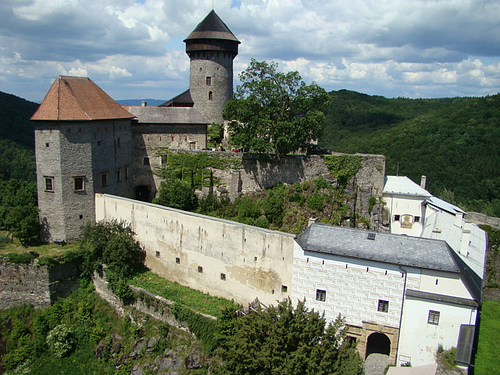

Location: Moravian–Silesian Region Map
Constructed: 1329-1332 by brothers Vok and Pavel Hrutovic
Open:
Apr- June, Sep- OctL 9am- 4pm
July- Aug: 9am- 5pm
Closed: Mondays
Tel. 554 219 863
554 295113
Entrance Fee:
Adult: 80
CZK
Children, seniors, students: 40 CZK
Family: 200 CZK
Sovinec Castle (Hrad Sovinec), also known historically as Eulenburg, is
a majestic medieval fortress located in the Moravian-Silesian Region of
the Czech Republic. Perched on a cone-shaped hill in the Nízký Jeseník
mountain range, it stands as one of the largest castle complexes in
Moravia and a testament to Czech resilience through centuries of
conflict. Built in the 14th century, the castle has evolved from a
Gothic stronghold to incorporate Renaissance and Baroque elements,
serving roles from a Hussite bastion to a prison during World War II.
Today, it attracts visitors with its well-preserved fortifications,
historical exhibitions, and cultural events, set amid picturesque
countryside. Its extensive defenses from the Thirty Years' War are among
the most significant in Central Europe, making it a key site for history
enthusiasts.
Sovinec Castle is situated in the village of Jiříkov, within the Bruntál District of the Moravian-Silesian Region, at coordinates 49°50′13″N 17°14′46″E. It occupies a strategic position on a rocky spur overlooking the valley of the Low Jeseník (Nízký Jeseník) hills, providing commanding views of the surrounding forested landscape. The castle's elevated location at approximately 500 meters above sea level made it an ideal defensive site historically. Nearby attractions include the town of Bruntál with its chateau and the Kosárna museum in Karlovice, offering insights into rural Moravian life. The region is known for its natural beauty, with hiking trails and outdoor activities enhancing the castle's appeal as a tourist destination.
The origins of Sovinec Castle trace back to the early 14th century,
with construction occurring between 1329 and 1332 by brothers Vok and
Pavel of the Hrutovic family (later "of Huzová") to secure their
territorial borders amid disputes with the Olomouc bishops. The family,
one of Moravia's oldest ruling lineages, adopted the name "of Sovinec"
and played a prominent role in regional politics. By the 15th century,
it became a pivotal Hussite stronghold, hosting key figures like Prokop
Holý and Sigismund Korybut during the Hussite Wars. The lords supported
King George of Poděbrady's unification efforts but faced devastation
from Hungarian King Matthias Corvinus in 1474.
In the 16th century,
the castle prospered under owners like Vok Pňovský, who expanded mining
operations for gold, silver, and iron. Sold in 1543 to Kryštov of
Boskovice, it was transformed into a Renaissance residence. Ownership
shifted to Jan the Elder Kobylka of Kobylí, a Protestant leader, until
1623, when it was acquired by Karl I, Prince of Liechtenstein, and
entrusted to the Teutonic Order post-Battle of White Mountain.
During
the Thirty Years' War, Sovinec was captured by Danish forces in 1626 and
fortified against Swedish invasions in 1643, though it fell to Swedish
General Torstenson. It lost military relevance by 1650 but remained
under Teutonic control. In the 18th and 19th centuries, it served as a
seminary, forestry school, and summer residence for the Templar Order.
Nazi occupation during World War II turned it into a prison for French
POWs and antifascists; it was burned in May 1945. Reconstruction began
in 1951, with major efforts in the 1960s and 1990s, restoring key
structures. During the communist normalization period, it provided a
space for banned Czech artists.
Sovinec Castle exemplifies a blend of architectural styles, starting
with late Gothic foundations and incorporating Renaissance and Baroque
modifications. The core structure includes massive fortifications,
particularly from the Thirty Years' War, which are among the
best-preserved in the region. Key features include the round stone tower
"Lichteinsteinka," connected by underground passages, and late Gothic
gate wings with engravings of historical insignias. Renaissance elements
appear in portals and halls, such as the Boskovický Hall and ornamental
sandstone gates added by Vařinec Eder.
The castle complex spans
multiple courtyards, with the fifth courtyard featuring a Gothic gate to
the inner palace. Defensive elements like watchtowers, fortified village
walls from the 15th century, and extensive ramparts highlight its
military past. A fire in 1784 damaged parts of the fortifications, which
were not fully repaired, but 19th- and 20th-century renovations have
maintained its romantic, layered appearance, visible in the gradual
expansions from Gothic through Baroque periods.
While specific legends are not prominently documented, Sovinec's history is rich with notable events, including its role in Hussite discussions and the signing of a protest against Jan Hus's execution. It endured sieges during the Thirty Years' War and served as a symbol of resistance. Post-WWII, its use as a haven for dissident artists during communist rule adds a layer of cultural significance. Since the 1980s, curator Jindřich Štreit has organized exhibitions, concerts, and theatrical performances, fostering its modern cultural vibrancy.
Sovinec Castle offers a range of attractions, including guided
tours of its medieval buildings, exhibitions on its history, and a
modern art gallery. Visitors can explore the wine cellar in the
porter’s lodge and ongoing repairs to halls and the former armory,
which is being converted into a library. The site hosts medieval
fairs, sword tournaments, and cultural events in a period setting,
providing immersive experiences.
The castle is open to the
public, with contact details including address (Hrad Sovinec,
Sovinec 58, 793 51 Jiříkov), email (sovinec@mubr.cz), phone (+420
554 219 863), and website. It's ideal for those interested in
history, architecture, and outdoor activities in the surrounding
Jeseník hills.